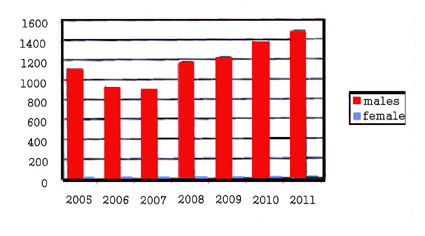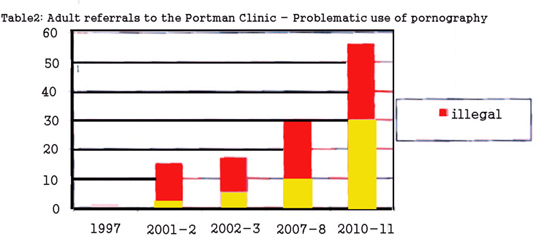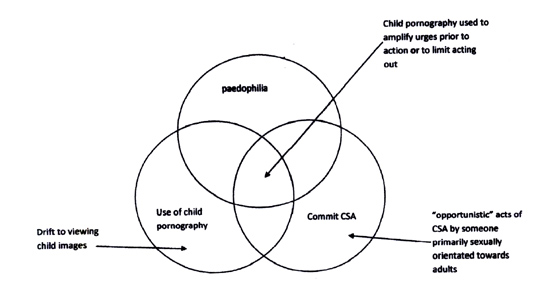|
|
internet pornogrpahy
|
Problematic use of Internet pornography and paedophilia - What is the risk of
someone who looks at child pornography also committing a contact sexual offence
against a child? And can the internet create paedophiles?
Heather Wood; Consultant Adult psychotherapist and Clinical Psychologist,
Portman Clinic, Tavistock and Portman NHS Foundation Trust.
The legal framework for internet crimes in England and Wales was established in
1998. Between 1999 and 2005 there was a fivefold increase in convictions for
child pornography (from 238 in 1999 to 1,296 in 2005) Since 1999, the rate of
convictions dipped briefly, but has continued to climb and shows no signs of
levelling off.
(Table 1. )

Note that the number of women (blue in the table) convicted of such crimes is
extremely small in comparison: the figure has been under 10 every year. There is
a marked gender difference in convictions for these crimes.
At the Portman
Clinic, an NHS outpatient psychotherapy clinic for people with problems of
compulsive sexual behaviours, criminality and violence , the same trend was
recorded. In 1996 there were no referrals for compulsive use of internet
pornography, in 1997 there was just one; in 2010-11 this was a feature in the
presenting problems of 29% of all referred patients, half of whom half had used
illegal, child pornography.
(Table 2) <

With any new phenomenon one would expect to see an increase in prevalence as it
becomes established, but we are not seeing any sign of the rate starting to
plateau. How do we understand this apparent increase in the prevalence of an
interest in child pornography? There are a number of possible explanations:
-
The internet allows the detection of previously covert illegal behaviours.
-
People who would have offended off-line have shifted to on-line offending.
-
internet sex acts as a catalyst, facilitating paedophilic or extreme sexual
interests.
It seems likely that all of these are operating. So what is the risk
that an internet offender, with no previous convictions, will re-offend, or will
progress to a contact offence against a child? One might imagine from reactions
to internet crimes in the press, and sometimes in statutory services, that the
risk was about 30%, or even 50%. In practice, however, rates are very low,
(Table 3) Recidivism rates with internet or contact offences for child
pornography offenders with no previous convictions:

These are crimes which are under-reported, and with a new phenomenon, timescales
in studies are relatively short, so the conviction rates may increase with time.
But it is clear that a conviction for internet pornography does not, in the vast
majority of cases, signal a high risk of committing a contact offence against a
child.
It is also possible that those who commit a subsequent contact offence
have not moved from pornography to action, but that they actually had prior,
undetected contact offences, and have simply repeated something they had done
before. The relationship between a consistently paedophilic sexual orientation,
viewing child pornography and committing contact offences against children can
therefore be represented diagrammatically as follows
(Table 4)

These circles are not drawn to scale, but the crucial thing to
stress is that the circles are not coterminous. There are people who commit acts
of sexual abuse against children who are not consistently paedophilic in their
sexual orientation, and there are people viewing child pornography who are not
consistently paedophilic.
Amongst people with prior contact offences and
consistently paedophilic sexual interests, we know that some may use child
pornography to increase arousal in preparation for action, but there are others
who turn to child pornography to attempt to limit their acting out and to reduce
the risk that they will harm a live child.
Research on the impact of looking at
pornography which was conducted prior to the wide availability of internet
pornography came to a similar conclusion, that looking at pornography is most
likely to have the strongest impact on people who are already predisposed to
commit sexual offences, such as those who have already committed such offences.
In general, looking at pornography does not automatically influence actions.
If
viewing indecent or abusive images of children online is not a rehearsal for
child abuse, why do people look at it and what purpose does it serve in people's
minds? The reasons why people look at child abuse images usually have very
little to do with sexual desire, as one might think of sexual desire for another
adult.
Many people report using pornography because it enables them to feel more
powerful, or less depressed, or it 'soothes' feelings of stress or anxiety. lt
is not always clear how this works.
Some people who are struggling in their own
lives or are in trouble, find comfort in looking at images of someone else (in
this case, a child) who is in a powerless or vulnerable position; this can
enable the viewer to feel like the stronger one. Sometimes people feel that they
are not fully adult and are a child themselves; in this state of mind, they
imagine sexual 'play' with another child.
Some adults look at images of children
they wish that they had been, or children they wish to see hurt or punished.
Sometimes it takes them back to abuse which they experienced in childhood, which
may have been exciting as well as frightening and distressing.
Where does an
adult's sexuality, their sexual preferences and fantasies, come from?
It
develops through childhood, and is influenced by biology, the typical patterns
of relating within the family, traumatic and abusive experiences in childhood,
as well as exciting and pleasurable experiences. These all “knit” together to
determine a person's characteristic sexual interests.
What internet sex appears
to do is to remove inhibitions and repression so that, in vulnerable people, the
sexual adaptation which someone has arrived at as an adult, "unravels". Internet
sex can create a very excited state of mind, in which people imagine there are
no witnesses to their actions, and no consequences to their actions.
In
vulnerable people, or people who are heavy users of internet pornography this
may open the door to repressed thoughts and fantasies, some of which relate to
the childhood roots of sexuality, and, ultimately, to children. Key points: - It
is no longer realistic to see paedophilia in dichotomous terms: i.e. either
someone "is" or “is not" a paedophile.
It is possible to be a bit paedophilic,
that is, to have some sexual thoughts about children but to mostly be sexually
interested in adults. Some people are paedophilic at some times and not others.
- For most people, internet sex is an extension of sexual fantasy, not a
rehearsal for action.
- The prevalence of sexual fantasies involving children
may reflect the continuity between childhood experience and adult sexuality.
Although in law we make a clear demarcation between adult sexuality (for people
over 16 or 18) and children, in nature there is a continuity between the
developing sexual life of a child or adolescent, and their adult sexual
identity.
Does the internet create paedophiles? No, there is no good evidence
that it can do so. Can internet sex reveal, crystallise and inflame potentially
paedophilic currents within the personality? Yes, both clinical observation and
accumulating research evidence regarding internet crimes suggests that it can do
so.
- Dr. Heather Wood.
|
Press back browser button to return to the
HOME PAGE
| |



